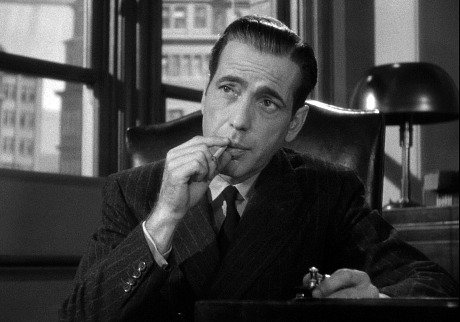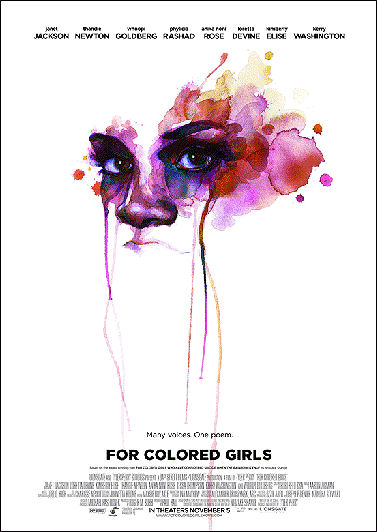Underlining a long-held view of mine that the Regal Union Square plex is one of the worst places you can see a film (partly for the cruddy projection, partly because of the popcorn-and-licorice-gorging, Converse-wearing loudmouth animals who always attend evening showings), Bonnie Fuller tweeted last night from a Regal Union Square showing of The Social Network that “disaster” had struck….”A BULB BLOWS! Movie theater can’t FIX! Packed theater GROANS! Lucky there’s no full-on mutiny over cancelled screening.”
No Sierra Madre
Warner Home Video’s new The Maltese Falcon Bluray is quite nice as far as it goes — slightly sharper than the most recent DVD, inkier blacks, more of a true-celluloid look — but it’s not as drop-dead beautiful as their Treasure of Sierra Madre Bluray, which I went apeshit over a few days ago. I guess I was expecting a new dimensional creamo experience, and this didn’t quite happen when I popped the disc in.

For whatever reason (i.e., the quality of the photographic elements in 1941 as opposed to 1948?) aren’t as finely tuned as those for Sierra Madre, and watching this new Falcon is just not a levitational thing. It doesn’t have that “oh, my God, look at those values and that razor-sharp quality” feeling. I’m not panning it. The Warner Home Video guys did a solid job and made a fine-looking version that slightly tops the DVD, but I knew 20 seconds after the film began that that “wow” quality we all know and love — call it exceptional silver schwing — just wasn’t happening.
Glottal Sound
Sony is projecting a $23 million haul for The Social Network‘s opening weekend, according to Box Office.com’s Phil Contrino. $8 million on Friday, $8.9 million on Saturday and a projected $6.1 million for Sunday.
That’s okay because The Social Network will hang in there for the long run. But it’s not the balls-out opening I was looking for. No way it’s the movie’s fault or that of the marketing. It’s simply the failure of a good portion of the American public to come out of their gopher holes and breathe in the cultural air and smell the fresh-brewed coffee. It’s all those 20something slackers thinking they’ve got enough Facebook in their lives without absorbing a movie version plus Average Joes wondering if it’s absolutely essential to see theatrically plus the slouchy mentality and class resentments of Joe Hinterland Popcorn.
Wine in the Afternoon
Learning Italian, the fourth Kevin Costner-Kevin Reynolds collaboration, is now in pre-production and set to shoot in Sicily and Germany sometime soon, or at least in time for a 2011 release. An apparent period “comedy” (set in the mid to late ’80s?), plot is about some kind of low-key CIA agent (Costner) stationed in an Italian coastal town who’s assigned to monitor a KGB agent. “When both are called back to their respective countries,” the boilerplate synopsis reads, “they decide to concoct a fake threat so they can continue to live in Italy.”
It doesn’t sound, in other words, like a coiled-spring hijinks comedy as much as a laid-back, quality-of-life mood piece with heh-heh laughs, possibly in the vein of Local Hero or Billy Wilder‘s Avanti or that line of country. The education alluded to in the title refers, I’m guessing, to a laughing Mediterranean way of life more than language.
What’s the difference between “heh-heh” laughter and “no-laugh funny”? I don’t know. Maybe no difference. You tell me. The definitions have to be sorted out.
The KGB agent part is apparently uncast but HE is respectfully begging Costner to not choose an actor who will torture the audience to death with a thick Russian accent. That means don’t hire Mickey Rourke. Not after that tearful “I remember a Bosnian woman I didn’t save” scene in The Expendables. In my view that one scene wiped out all the good will Rourke built up during his entire “Rourke is back and he’s sorry for being a dick in the ’80s and early ’90s” Wrestler campaign.
When Learning Italian was first announced last February everyone recalled the stormy relationship between Costner and Reynolds, particularly their arguments and editing-room lockouts during the making of Robin Hood: Prince of Thieves and especially Waterworld, which Reynolds left towards the end of filming. And yet, according to Deadline, the two have remained friendly. I’m predicting they’ll come to physical blows during the editing of Learning Italian.
Blanket Caveat
If it’s based on a comic book and not directed by Chris Nolan, Sam Mendes, Terry Zwigoff or Bryan Singer, it’s probably going to tax your patience or, more likely, flat-out exasperate or infuriate. This is my belief.
Update: My initial posting was tapped out prior to a screening of Robert Schwentke‘s Red (Summit, 10.15), and I was feeling a little bit of an anticipatory “uh-oh.” I was initially only thinking of Singer’s X-Men flicks and Nolan’s two Batman movies. I should have also been thinking about Mendes’ Road to Perdition, Jonathan Mostow‘s Surrogates, Zwigoff’s Ghost World and Art-School Confidential, and the Wachowski’s V for Vendetta.
Screening in Berlin?
Thank you, Terrence Malick, for giving me one final finger by apparently having decided to open The Tree of Life at the Berlin Film Festival. First you blew off Cannes 2010 and then you signed with Fox Searchlight, which resulted in a decision not to release in 2010, and now this. Now I’ll have to shell out big dough to fly to Berlin in February, or suffer a certain loss of face by not being at the very first screening of The Tree of Life.
The Berlin booking isn’t confirmed but an allegedly well-informed guy named Cedric Succivalli has, according to In Contention‘s Guy Lodge, tweeted that The Tree of Life‘s French distributor EuropaCorp “has confirmed a February 23 release date, obviously ruling out a Cannes appointment three months later.” Malick’s last two films have played Berlin so draw your own conclusions. Sundance is almost certainly a dream.
Defense
You’ll only see this in hotel-room hallways during junkets, but whenever a big star needs to make his/her way from one room to another, he/she will always be flanked on all sides by his/her publicists in military formation. One publicist in front of the celebrity, one behind and two on either side — a phalanx of five. The idea, I guess, is that if some nutjob journalist or hotel employee makes a wrong move, the publicists will be able to block.
Window Dressing
Sidestepping for the time being the near-certainty that Tyler Perry‘s For Colored Girls (Lionsgate, 11.5) will be regarded as a rank embarassment by people of taste, this is a relatively alluring poster. Congrats to Lionsgate’s Tim Palen and his marketing team. Seriously.

Meatballs
I can relate to this. I was once an Arjuna-quoting Bhagavad Gita mystic, but I gradually gave it up for the bolt and the buzz — for a be-here-now philosophy and the lure of fast living, fast women, big-city life, the drama of it all, vodka-and-lemonades (before giving those up in the mid ’90s), a movie-chasing life and great-looking T-shirts.
No Quarter
I had about twelve minutes with Fair Game director Doug Liman about an hour ago — not long enough. We talked a bit and I recorded it all (which I’ll either post as an audio file or use as the basis for another piece), but it seemed as if we barely got going before Movieline‘s Stu Van Airsdale was being ushered in for his quickie session. The quote that sticks in my head was Liman saying “I’m tough on myself.” Down with that. The more demanding you are on yourself, the better it is for your audience.

Fair Game director Doug Liman on 10th floor of Manhattan’s Four Seasons hotel — Saturday, 10.2, 2:45 pm.
Had It
I understand why government guys and security people always drive officials and/or clients around in big, black, gas-guzzling Escalade SUVs. It’s because these vehicles say “macho badass,” “king shit,” “armour-plated,” “no messing around,” “heavweight,” “formidable,” impenetrable” and all those other studly statements. I am nonetheless sick to death of the sight of them — sick of watching SUV convoys cruising through big-city streets and down big highways in action thrillers. I’m looking for a variation of any kind…anything.
Octopus


A dark little joint near Second Ave. and 2nd Street — Friday, 10.1, 10:15 pm.

Friday, 10.1, 4:55 pm.

